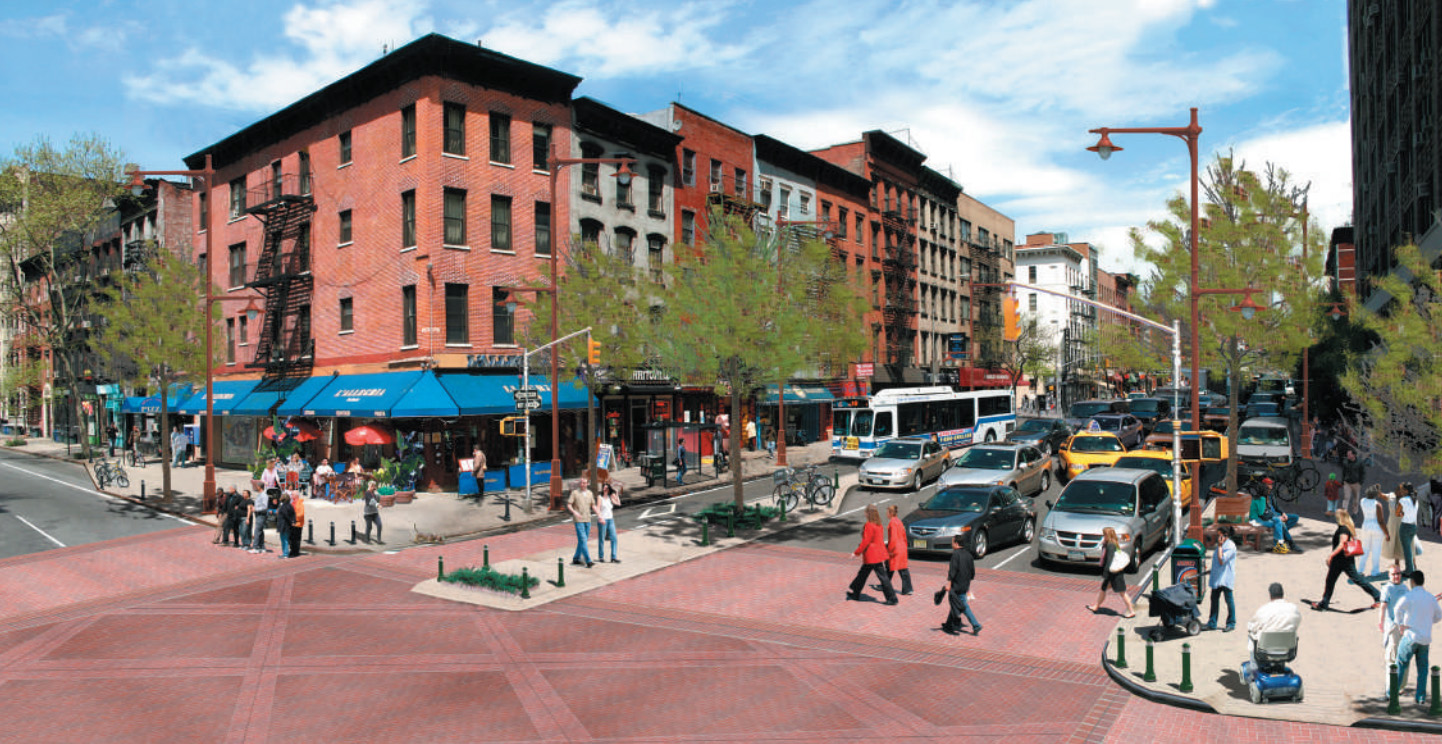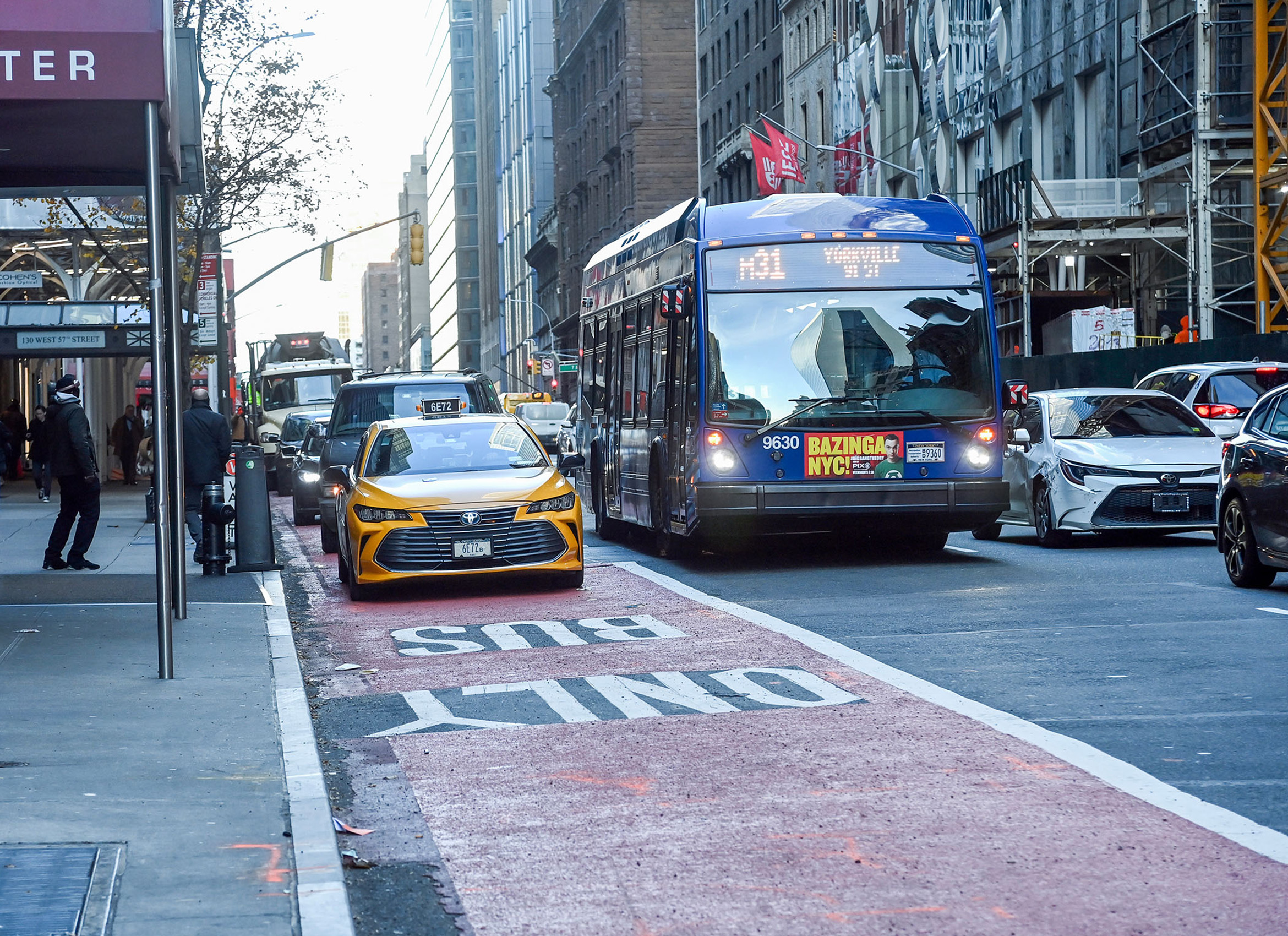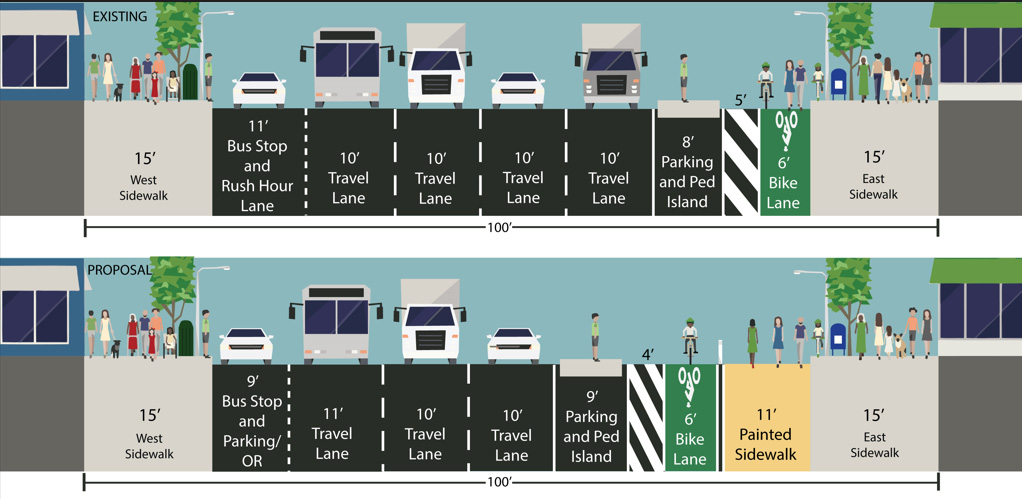People Movers
Community organizers give a window into the city they want and the work they’re doing to get there.
We are celebrating 15 years — and counting — of stories that are deeply researched and deeply felt, that build a historical record of what the city has been.
Senior citizens aided by wheeled walkers, tourists rolling suitcases off the Greyhound bus, and families with young kids in strollers share the streets of Hell’s Kitchen with idling intercity buses, cars in standstill traffic at the entrance to the Lincoln Tunnel, and e-bikes trying to find any possible path through. Where room to move is a hot commodity, congestion has led both to significant air pollution and a dangerous environment for pedestrians.
Since 2005, Christine Berthet has been organizing for safer streets in this car-crammed corridor. Alongside her neighbors in the Clinton Hell’s Kitchen Chelsea Coalition for Pedestrian Safety (CHEKPEDS), she’s diligently observed and documented on-the-ground conditions for pedestrians and taken this evidence to elected officials and city agencies to enact concrete changes. CHEKPEDS has secured interventions like split-phase traffic signals that prevent pedestrians from being hit by turning cars and 26-foot-wide “Super Sidewalks,” offering a model for interventions citywide. With the upcoming ten-year overhaul of the Port Authority Bus Terminal and the arrival of congestion pricing bringing bigger changes to the streetscape, we spoke with Berthet about keeping a close eye on pedestrian safety and mobility. – KR
After moving to New York City, how did you become aware of the issues of traffic and congestion in your neighborhood? And how did you start organizing?
I was going through my corporate life. One day, I decided to work from my home office. I heard massive amounts of honking which drove me nuts. I put my head outside, I looked at what was going on, and said: “Oh, I know how to fix it.” I put a PowerPoint together and started to go to the Community Board, and the Port Authority, and the Department of Transportation (DOT), and everybody. Then we just organized after that, because one person going around is not an effective way of doing things.
What were the big concerns at the start?
Safety. At the corner of West 38th Street and Ninth Avenue, a woman was killed by a driver turning; she was seven months pregnant. At the other end of the block, West 38th Street and Eighth Avenue, another person was killed; there were six or seven people killed on Ninth Avenue. We said: “What’s going on? This is crazy.”
Who was most receptive to you in the beginning?
None of the agencies were receptive, they discounted us as lunatics. That’s when we decided that we needed to create a movement. We organized a protest at McCaffrey Playground. People marched down Ninth Avenue, everybody had their panels. “Port Authority: You are killing us.” “DOT: You forgot about us.” Typical, angry panels. All the elected representatives came. We held a memorial march for all the people killed by drivers on Ninth Avenue.
Then we started to convert from negative to positive. We hired a nonprofit who helped us organize a charette where everybody came and said: “These are the problems. Let’s go and fix things.” We generated a report, the Ninth Avenue Renaissance. That was really important, because that’s one of the first livable street reports that was done in a very long time. And most of the people who worked on that report went on to work at DOT, which was even more important.
CHEKPEDS, the group you founded, works not just on street safety interventions, but also visualizing and understanding data about traffic fatalities. How did your CRASHMAPPER tool come to be?
Transportation Alternatives had a map. For whatever reason, they stopped updating it. My background in technology and data told me that without such a tool we would not be credible. We raised some funds. We found a developer. It’s very useful. Everybody’s using it.
When you look at the data, what do you see?
We see a lot of different things. Traffic deaths are up from last year but much lower than ten years ago. Pedestrian deaths have dipped but cyclist deaths have increased. I would guess because there are so many more cyclists, and e-bikes and mopeds have entered the mix and do go faster. We also see that SUVs now account for a substantial amount of all crashes. The reaction is: “Okay, what the DOT is doing is working for the pedestrians, and that’s good news.” But the DOT could apply certain treatments systematically to make streets safer faster and we do not see this approach at work. It’s still project by project. We think you have to roll out certain safety features across the board.
What are some of the treatments that you’ve advocated for?
We have advocated a lot for exclusive split-phase signals, a red arrow signal for cars while pedestrians and bikes go through. This is at the intersection on every big avenue with a bike lane. I consider that the most important feature, and yet it’s very difficult to get.
The first exclusive split-phase signal in the district was at 41st Street and Ninth Avenue, the right turn. A person was killed there, and the Community Board said to DOT: “We need a solution.” DOT engineers said: “No, no, no, it is not warranted.” When there was a second person killed, DOT installed an exclusive split-phase, and it works perfectly.
We also obtained one at 43rd and Ninth. It’s a blinking yellow arrow. Everyone who lives in the residential complex next to it — a majority are seniors — has expressed so much gratitude for this measure, because they see it and they feel: “I am protected.” At the same time, the drivers see they are supposed to slow down.
Another big effort you’ve made is advocating for “Super Sidewalks,” which take lanes of traffic and convert them into additional space for pedestrians. What does this infrastructure look like?
As an interim treatment, which is much faster and lower cost that a concrete sidewalk, the City repurposes a traffic lane or two and lays down truffle paint (the DOT’s term for the grey-brown paint it uses), like you see at some street corners. Then, DOT puts a light separation, or sometimes planters with greenery, and installs bike and floating parking lanes. Then, if possible, DOT will add concrete islands at the corners, which is safer for pedestrians. It forces the cars to turn slowly. In some places, there is a hard separation between the bike lane and the cars.
The Department of Environmental Protection (DEP) was working to bring the third water tunnel to the city. The end of the tunnel is on 48th Street, on Tenth Avenue. In order to hook up every building to the new pipe, they had to expand to the east. It’s massive work. For eight years, Ninth Avenue hosted the construction staging, occupying two lanes of traffic. When the projects wrapped up, during Covid-19, DEP notified the Community Board: “We are done. We’re going to rebuild it to the way it was.” And the community said: “Whoa, wait. We don’t want it the way it was. We want you to do a Super Sidewalk.” DOT was interested because they thought, “Hey, we were going it do it, but now DEP is going to pay for it instead of us.” So, the agencies and City Hall agreed it would be a good idea.
How have the Super Sidewalks been working out?
On Eighth Avenue it’s working really well, because there’s a lot of people who need a lot of space. On this part of Ninth Avenue (51st to 58th Streets), there are fewer people. The delivery cyclists look at that space, see no one there, and say, “let’s go.” Then pedestrians are afraid to go, so we need to change the balance here and have the pedestrians feel safe and occupy the space. DOT just installed pedestrian decals.
Enforcement of these spaces is so tricky. As I go around the city, I often see cars using infrastructure that’s not meant for them, parked on the sidewalk or in the bus or bike lane. What sorts of enforcement issues are you seeing around your neighborhood?
There are two aspects. First, street design: DOT needs to put more vertical separation between the lanes as is done in other cities, like Paris. Changing the structure of the street is a big deal and adding signage or information saying this is new and that is what it is for.
Then, we need a new public space enforcement unit. Not in NYPD — separately. Clearly, NYPD is not interested. For them, it’s an insult to be put on traffic. Enforcement, in the mind of NYPD, is of personal property (stealing) and real crime (killing someone with a gun). That’s their thing. If this is the way it is, then there is no chance of getting a reasonable traffic enforcement.
But if we take all the parking and traffic agents and put them into a separate unit and give them way more to do — What’s on the sidewalk? What’s in the bike lane? What’s happening with the dangerous drivers? — and make them responsible for all those aspects of the streets, then we would have real enforcement.
When you look at Vision Zero, there are three legs, right? We are working on one leg — engineering — without education or enforcement. You need to change the culture. Trying to rely exclusively on design is unrealistic. It’s not that you should rely entirely on the other legs for success, but each of them reinforces what engineering is changing.
In public remarks at the launch of the Ninth Avenue “Super Sidewalk,” you spoke about the project “reclaiming the space that Robert Moses took from us.” Can you say more about how you’re reimaging our streets?
When I started to work at the Community Board, the public was up in arms at sidewalk cafés that took too much sidewalk space. There is not enough space for everyone: fast-walking commuters, slow-walking seniors, disabled people using wheelchairs, mothers with prams, tourists with rolling luggage. It’s tangible. One slows down, others walk in the bike lane or roadway. The population fights against each other.
If you see the sidewalks of Ninth Avenue, they are narrower by five feet. By changing this lane to a Super Sidewalk, we’re reclaiming the space the automobiles have taken from the people. It is really exhilarating: now we have space, we can breathe, there is no fighting when we walk, we can live harmoniously with each other.
People look at infrastructure, and it can feel so set in stone. It becomes difficult to imagine it existing differently.
At the Community Board a long time ago, I remember a conversation where I said: “We need more sidewalk space.” A land use expert told me: “The buildings are not going to be moved backward.” I said: “No, but we can take a lane of traffic.” Boom, change of perspective: There is another tool there.
Lots of agencies are in charge of what’s on the sidewalk, and it doesn’t work. The sidewalk cafés are the DOT. Storm enclosures: that’s Department of Buildings. The garbage containers: Department of Sanitation. The street trees: Department of Parks. And hydrants are with FDNY.
If you have a broken sidewalk, where do you go? You complain to DOT, but DOT has a process where it takes 18 months before it’s fixed, while the roadway is supposed to be fixed in 15 days. Why are the timelines so different?
In addition to pedestrian safety, you’ve also looked at air quality in your neighborhood.
As a kid, I suffered from very bad asthma, so I was very sensitized to the subject. In 2009, there was a revision to the idling law, which established a one-minute rule in front of schools. CHEKPEDS worked on this new law: We delivered leaflets, called the electeds and told them what we wanted.
We have always had long-distance buses, which idle while loading and unloading passengers. Residents are obsessed about it: “You’re spewing bad air.” But we did not have specific data. So we got a grant from the West Side Community Fund and the City Council Discretionary Fund, bought Plume personal air monitors and organized 25 volunteers. We sent a mailing to CHEKPEDS and the Community Board mailing list, and people contacted us. The group selected the locations that should be measured twice a day. Plume helped us visualize the results, and we had our data: “Look, we’re not kidding, this is really bad.”
The results showed that the worst offenders — the vehicles who created the most pollution — were the cars queuing up for the Lincoln Tunnel on Ninth Avenue. Typically, you see two or three lanes of cars waiting. When the light turns green, they advance, even if there is no room. They block the pedestrian crossings and the intersections. This goes on for five hours a day. The idling generates more pollution than the buses. Most of the buses have converted to clean diesel, and therefore, their engines are much cleaner than we give them credit for.
The Port Authority Bus Terminal is a big contributor to traffic and congestion in the neighborhood, and is in the midst of a big plan for a renovation to expand its capacity. Designs were released in February, slated to be completed by 2032. How is CHEKPEDS organizing around this?
The Port Authority’s first impulse was to raze the neighborhood to install a big terminal. We had our elected officials stomp their feet and say, “No way.” The Port Authority changed their strategy. We are going to keep our neighboring stores, church, and traditional buildings.
If you go on 39th Street now, you will see parked buses on both sides. The big benefit in the project right now is the plan to take all the long-distance buses off the streets and put in the terminal and a separate staging and storage building. The Port Authority will return the space to the community, and the residents can define what to do with the space.
We’re certainly in a moment of great change on our streets. What else is on the horizon that you are thinking about?
I’m very concerned with how new technologies are deployed, ensuring they do not encumber our streets with long-term deleterious side effects like we have seen in earlier decisions.
The city just approved autonomous vehicles (AVs) in New York City, but I am concerned it has not done the proper due diligence on them. AVs are driven by software; we should audit the code to make sure it complies with the rules of the road and the context of New York City. How do we know if the developers took a permissive approach, as a driver would do: “You don’t get a ticket until 35 mph, so let’s use that instead of 25 mph?” A lot of decisions are baked into the software, and I would like the City to evaluate those decisions by audit or testing — before someone gets hurt.
The second thing I got very involved in is the EV chargers on the sidewalk. To me, Level 2 (slow) chargers shouldn’t be installed on the sidewalk. Charging should take place in dedicated hubs with Level 3 (fast) chargers.
Another big change is congestion pricing.
We started to work on it in 2007 with Bloomberg, and it was so exciting at the time. We went to every meeting. We went to Albany. We did everything, because, to us that was the silver bullet. We were crushed when we lost.
This round, we worked it differently. We published a study you can find on our website for communities outside of New York City. We tried to find the argument that would sell to non-New York City drivers. “What’s in it for you? You will not have to pay as much to fund the MTA. More funds will be available to your neighborhood.” In that study, we found that most people will save lots of commuting time and there will be less crashes. I think we will all benefit.
The views expressed here are those of the authors only and do not reflect the position of The Architectural League of New York.
Community organizers give a window into the city they want and the work they’re doing to get there.




